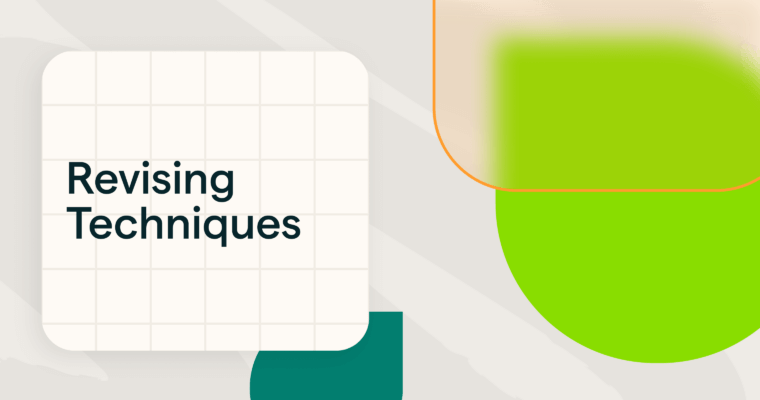
Key takeaways:
- The 5 Whys analysis is a problem-solving method that uncovers a problem’s root cause by asking “Why?” repeatedly.
- It’s especially effective in writing because it reveals issues that surface edits can’t fix, like vague reasoning, structural gaps, or fuzzy ideas.
- Using 5 Whys helps writers strengthen their writing’s logic, clarify its purpose, and revise their work strategically.
- Use 5 Whys during drafting or revision by staying neutral, writing each step down, and stopping when you reach an actionable insight.
If you’ve ever rewritten the same paragraph several times without solving what feels “off” about it, you’ve experienced the problem the 5 Whys solves. Initially developed in the manufacturing world to diagnose system failures, this simple problem-solving strategy is also one of the most powerful tools at a writer’s disposal.
The 5 Whys helps you look beyond surface issues like grammar mistakes, awkward phrasing, and weak transitions to uncover the deeper reason why your message isn’t landing. Each “Why?” moves you closer to the core issue, so your revisions target the real problem, not just the symptoms.
This guide explains what the 5 Whys analysis is, why it’s so effective for writing, and how you can use it to clarify ideas, improve your reasoning, and strengthen any draft.
Table of contents
- What is the 5 Whys analysis?
- Why use the 5 Whys in writing?
- How to use the 5 Whys in writing
- 5 Whys examples in different types of writing
- Best practices for using the 5 Whys
- Common mistakes to avoid when using the 5 Whys
- Make your 5 Whys analysis more robust with Grammarly
- 5 Whys FAQs
What is the 5 Whys analysis?
The 5 Whys analysis is a root-cause strategy that helps you uncover why a problem exists. As its name implies, it works by asking “Why?” repeatedly. Typically, the problem-solver asks “Why?” five times, but you may need to ask it more or fewer times to find an actionable answer. Developed by Sakichi Toyoda and refined within Toyota’s manufacturing process, it remains one of the simplest, yet most effective diagnostic tools available.
For writers, 5 Whys is not about machines or workflows. It’s about thought clarity. Instead of asking why a product failed, you’re asking why your thesis feels vague or why your proposal lacks impact. Each “Why?” exposes a deeper layer of reasoning until you discover the true cause of confusion.
While other root-cause tools like fishbone diagrams map multiple possibilities, 5 Whys focuses on depth rather than breadth, making it ideal for isolating a single writing issue at a time. It turns fuzzy reflection into a clear process: question, analyze, and revise.
As a prewriting technique, it helps you test early ideas before drafting. During revision, it becomes a diagnostic exercise for identifying logic gaps or structural flaws. It’s a low-pressure way to think more critically about your work.
Why use the 5 Whys in writing?
As they revise their work, writers often fix what’s visible, like awkward sentences or unclear transitions, but miss issues like a shaky argument, an undefined goal, or assumptions left unexplored. The 5 Whys method helps you get past cosmetic changes and ask better questions about your intent and reasoning. Beyond this, here are five benefits of using the 5 Whys in your writing.
It’s simple and accessible
You don’t need templates or special tools to use the 5 Whys. All it requires is curiosity and a willingness to write down each “Why” and its answer. This slows your thinking, giving you time to focus on each specific component at work. You can use the 5 Whys on a sticky note, in a digital document, or as an exercise with Grammarly’s AI, wherever you write.
It promotes critical thinking and deeper revision
When a paragraph feels off, rewriting it might not solve the problem. Asking why it feels off forces you to look at its structure and purpose. Here’s a visual example of the 5 Whys in action:
“This paragraph feels unclear.”
Why? The topic sentence doesn’t match the evidence.
Why? The claim shifted mid-draft.
Why? The outline wasn’t specific enough.
Root cause: weak planning.
Instead of rephrasing a confusing sentence, the 5 Whys pushes you to strengthen your reasoning from the foundation up.
It breaks recurring patterns
Maybe your feedback always mentions the same issues, like “too general,” “lacks focus,” and “unclear argument.” Using 5 Whys helps you trace those patterns to their sources. Often, you’ll find the issue isn’t your writing skill but your approach to defining scope, research, or purpose. Once you’re aware of these difficulties, you’ll likely find them easier to spot and correct in your future writing.
It works across different writing styles
The 5 Whys can be used in nearly any writing context:
- Academic writing. With the 5 Whys, you can clarify your thesis or fix a disorganized argument. They can also expose logical fallacies and strengthen connections between concepts.
- Professional writing. In professional writing, the 5 Whys can help you improve clarity in reports, proposals, and marketing copy. Similar to academic writing, this strategy can also help you identify connections between concepts, strengthening the position you take in your writing.
- Creative writing. The 5 Whys is a way to poke through plot holes, improve a story’s logic, strengthen character motivation, and ensure that any literary devices you use are doing what you’d intended them to do.
- Technical writing. Through a 5 Whys analysis, you can ensure instructions and microcopy are rooted in user context and provide the information users actually need.
Whether you’re revising an essay or developing an editorial strategy, 5 Whys helps you diagnose the underlying issue rather than editing at the surface.
How to use the 5 Whys in writing
To use the 5 Whys method to resolve an issue in your writing, first identify a specific issue. Then, ask “Why?” until you reach the core cause through a series of answers. The last step is to decide which action to take to correct it. Here’s a step-by-step walkthrough of the 5 Whys:
1. Identify the problem
Pick one issue that feels unresolved. Maybe your introduction lacks impact, or your analysis feels repetitive. This issue might be identified through peer or instructor feedback. In any case, define it clearly.
Example: “My argument feels unconvincing.”
2. Ask “Why?” and write down your best answer
Be specific and neutral. Writing out your answers helps prevent circular thinking.
Example: “Why is my argument unconvincing?” → “Because my evidence doesn’t strongly support my claim.”
3. Repeat this process
Ask “Why?” again. Then, write down the answer to this “Why?”
Example: “Why doesn’t the evidence support my claim?” → “Because I relied on outdated sources.”
4. Continue until you reach the root cause of the issue
Usually, after three to five rounds, you’ll hit the actual reason for the problem.
Example: “Why did I use outdated sources?” → “Because I didn’t refine my research question early enough.”
Root cause: unclear scope.
5. Identify an actionable solution
Now that you’ve identified the issue’s root cause, choose a fix that directly addresses it.
Example: Refine your research question, gather current studies, and identify relevant sources to cite before rewriting the section.
The 5 Whys method isn’t about self-criticism. It’s about curiosity. The more specific your questions, the more targeted your solutions can be.
5 Whys examples in different types of writing
Seeing the 5 Whys in action illustrates the method’s flexibility. Remember, not every problem will require 5 Whys. Take a look at these examples from a variety of writing contexts:
5 Whys in academic writing
Problem: The literature review feels weak.
- Why? It only summarizes sources.
- Why? The writer didn’t compare perspectives.
- Why? They missed the central debate in the field.
- Why? They focused on gathering information rather than analyzing how the studies relate to one another.
- Why? They didn’t fully understand that the goal of a literature review is to demonstrate critical engagement, not just report findings.
Root cause: Unclear understanding of the assignment’s analytical goal.
Solution: Rework the review to highlight relationships among studies, identify the main debate, and show how the research connects to the core question.
5 Whys in professional writing
Problem: The client proposal was ignored.
- Why? It didn’t highlight clear value.
- Why? Benefits were buried in dense text.
- Why? The tone was overly formal and internal-focused.
- Why? The draft reused old copy from internal reports.
Root cause: Failure to adapt messaging for the client’s perspective.
Solution: Rewrite with the client’s goals as the central branch of a new outline.
5 Whys in creative writing
Problem: The story’s ending feels flat.
- Why? The resolution is too easy.
- Why? The protagonist faces no real choice.
- Why? The conflict was resolved too early.
- Why? The pacing cut short key turning points.
Root cause: The story lacks rising tension.
Solution: Add a decision scene that forces the character to earn the resolution.
5 Whys in technical or UX writing
Problem: Users keep misinterpreting an instruction.
- Why? The step uses unclear jargon.
- Why? It assumes prior product knowledge.
- Why? There’s no tooltip or onboarding note.
- Why? The team prioritized minimal text in the interface.
Root cause: Missing user context in design planning.
Solution: Revise the copy and propose adding brief context within tooltips or quick-start guides.
Best practices for using the 5 Whys
Used thoughtfully, the 5 Whys technique can be a structured form of reflection for just about any challenge you face. To get even more value out of the 5 Whys, use these best practices.
Ask others for their perspectives
Ask a peer, tutor, or reviewer to help walk you through your questions. Someone less attached to your writing can challenge assumptions or spot missing context.
Example: A peer might ask, “Why does this claim feel abrupt?” and notice you skipped a transition paragraph.
Phrase each “Why” neutrally
Keep questions objective and focused on the writing, not on you.
Example: Ask, “Why is this paragraph unclear?” instead of “Why did I mess up this section?” This neutral framing prevents defensiveness and encourages problem-solving.
Use evidence from your draft
Answer each “Why” based on what’s actually written, not what you intended. Quoting or rereading the exact passage helps ground your reasoning in reality.
Example: If a transition feels weak, check the previous and following sentences to confirm whether they connect logically.
Stop when you reach an actionable cause
There’s no strict rule about asking “Why?” five times. Stop when your answer points to a clear, fixable issue.
Example: If the root cause is “outline too vague,” that’s a solid stopping point. Anything deeper, like “I was tired,” won’t improve the draft itself.
Common mistakes to avoid when using the 5 Whys
Asking “Why?” in a blaming tone
Self-criticism shuts down reflection. Focus questions on the work, not the writer.
Unhelpful: “Why am I bad at introductions?” Better: “Why does this introduction fail to engage the reader?”
Accepting assumptions instead of checking the draft
Answering based on your memory or intent leads to false conclusions. Reread the section before answering “Why?” This way, you’re responding to the text itself.
Stopping too soon
If you stop after one or two questions, you might fix symptoms of an issue, not causes.
Example: Editing a confusing sentence without realizing the confusion comes from a missing definition earlier.
Going too far
Over-questioning wastes time once you’ve hit a meaningful cause. Stop when you can correct the root cause of the mistake you identified.
Treating it as a standalone fix
5 Whys works best alongside other revision tools, such as outlining, brainstorming methods, or peer feedback, to strengthen your writing process.
Make your 5 Whys analysis more robust with Grammarly
Grammarly’s AI tools complement the 5 Whys method by providing clarity, structure, and insight at each stage of the writing process.
- Use brainstorming features to expand your first “Why?” into several possible causes or directions.
- Let Grammarly’s AI organize those ideas into a clear outline for revision.
- During editing, Expert Review can identify logic gaps and vague claims, guiding where to dig deeper.
- Reader Reactions helps you see how your writing lands with others, giving real-world data to support your analysis.
Grammarly doesn’t replace your judgment; it enhances it, turning each “Why?” into a clear step toward better writing. It also can’t replicate your voice or intent, so remember that it’s a tool, not a shortcut to strong writing.
5 Whys FAQs
What is the purpose of using the 5 Whys?
The 5 Whys method helps you uncover the root cause of a writing problem by asking “Why?” repeatedly. It moves you past surface fixes to reach meaningful revision.
Do I have to ask “Why?” five times?
Not necessarily. Five is a guideline. Stop once your answer leads to a specific, actionable insight.
Can I use the 5 Whys by myself?
Yes. It’s an easy self-review exercise, though feedback from peers or Grammarly’s tools can make it even more effective.
How does it differ from other writing tools?
5 Whys is diagnostic: It reveals why something doesn’t work. Outlining helps with structure, peer review provides feedback, and 5 Whys helps you understand cause and effect.
When should I use it?
Anytime something in your writing feels unclear. It’s valuable during brainstorming, drafting, and especially revision, when you need to pinpoint what’s blocking clarity or flow.






